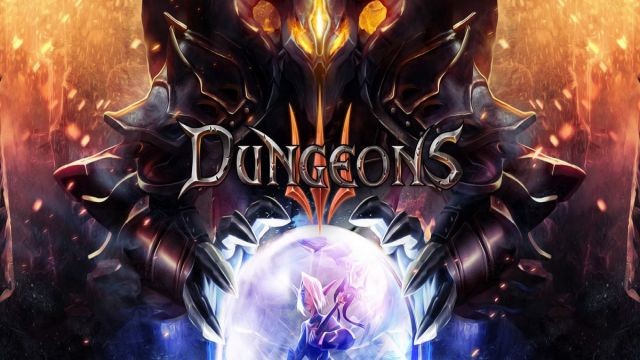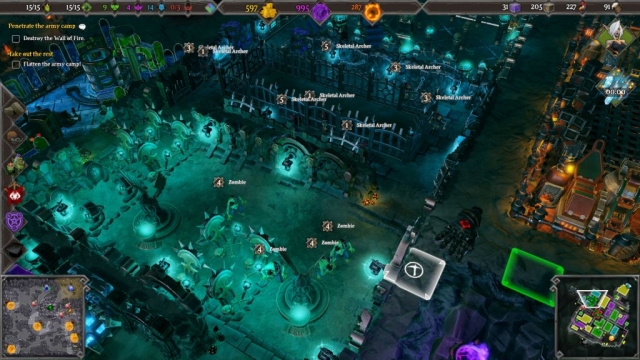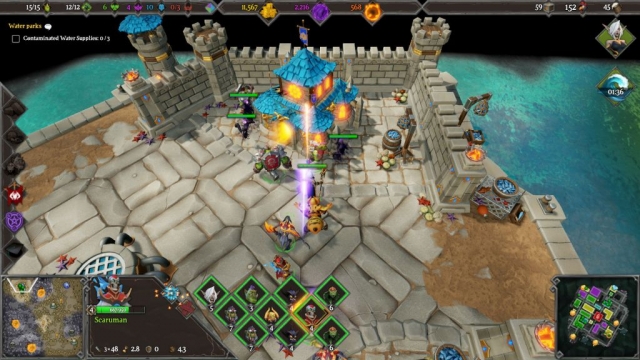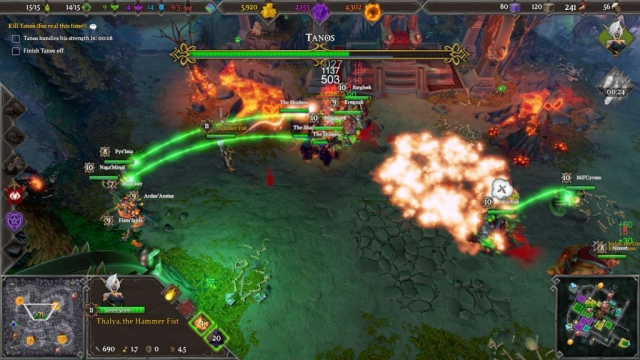Dungeons 3

Dungeons 3 is a new real-time strategy game from Realmforge Studios. It’s the third entry in the Dungeons franchise, following Dungeons (2011) and Dungeons 2 (2015). I reviewed Dungeons way back when it came out and was sort of meh about it, and then I didn’t bother with Dungeons 2 at all. Now I have Dungeons 3, and sort of surprisingly, it doesn’t have much in common with the original Dungeons — except, of course, that they both involve running a dungeon.
As Dungeons 3 opens up, you (as Absolute Evil) once again find some do-gooders who need to be thwarted. Their leader is Thanos the Paladin, and you make inroads into his rule by kidnapping his adopted daughter Thalya and converting her to Evil. Thalya then becomes your main hero unit in the game, and she leads your forces against Good.
Managing your dungeon is fairly easy, especially if you’ve played any city building games. You have to dig out rooms to keep your creatures healthy and happy, you have to maintain an economy by mining gold and collecting Evilness, and you have to defend your domain by building a variety of traps. At the start of the game’s 20-mission campaign, only a few rooms and traps are available, but then you gain more options as you progress.
Your dungeon’s rooms include things like treasuries (where you store gold), hideouts (where your horde creatures sleep), workshops (where your little snot minions build toolboxes for traps and other devices), arcaniums (where you store mana for spells), gobbler farms (where you grow turkeys for food), prisons (where you store enemy heroes for Evilness), and more. You also have a throne room in the middle of the underground where your dungeonheart is located. Enemy heroes try to destroy the dungeonheart, and if they succeed then you lose the mission. There are 19 types of rooms in total, giving you plenty to build.
The underground has one level, and it uses a square grid. To build a room, you just have to select the squares where you want your minions to dig. Rooms are more efficient if they’re surrounded by walls, so you only want to have one or two doorways into each one. Open floorplans don’t work well at all. Digging is free, and it sometimes uncovers gold, mana or supplies, so it’s always a good idea to set your minions to work exploring your domain to see what’s available.
To run your economy, you need to find gold nodes in your domain. These special squares are worth at l5,000 gold, and each one can keep your dungeon running for a while. There are also diamond nodes that are worth infinite gold, and if you find one of them (usually protected by spiders or dragons), then your money problems are solved. Gold is used to pay your creatures and build new rooms, so the more you have, the more powerful you can be.
Meanwhile, for the Evilness resource, you have to send your creatures to the surface and have them capture towns. Each town gives you a trickle of Evilness while you hold it, which allows you to perform research. Research topics include new rooms, spells, and traps, and Evilness also allows you to make Thalya and your creatures more powerful. Enemy heroes try to take back towns every so often, but as you capture towns and destroy other enemy spawn points, fewer and fewer enemies appear, making your job easier.
When enemies enter your dungeon, you have to defeat them before they can destroy your dunegonheart. All of the entrances into your domain are shown at the start of the missions, so there aren’t any surprises, and you can command your minions to dig tunnels — plus fill in some previously dug squares — to redirect all enemies to the same place, where you can set up a kill zone of traps.
The traps you get at the start of a mission aren’t very good, and they don’t deal a lot of damage to enemy heroes. So early on you have to use Thayla and your creatures to help defend your dungeonheart (by grabbing them and dropping them where needed). But later you get magic traps, and they’re so powerful they kill just about everything on their own, which makes dungeon defense a little boring. Traps include things like floor spikes, wall arrows, rolling balls (think Indiana Jones), tar pits, and thrashers (that swing around and hit all enemies nearby). About half of the traps are automatic and fire on their own, but the other half are controlled by you and require you to be paying attention.
So Dungeons 3 is part city-builder (constructing your dungeon) and part real-time strategy game (invading the surface). The problem is that Realmforge only used the lightest of lightweight elements from those genres, and the combination isn’t anything to get excited about. Plus, the campaign isn’t challenging at all. It’s ridiculously easy to defend your dungeon, as enemies never put any pressure on you. You just need to visit the surface at least briefly to capture a city (with returns as necessary to recapture it), and then you can just go into “turtle mode” and defend, research, and expand until you’re ready to conquer the rest of the map.
So I found all of the gameplay mechanics sort of boring — certainly playable, but boring because I was never worried about being defeated. Luckily, that doesn’t make the game a waste of time. For starters, each of the 20 campaign missions has three achievements attached to it — one just to beat it, but then two more that add extra challenges (such as meeting objectives within a severe time limit or beating the mission without taking any losses). There is also a “hellish” difficulty setting that makes the missions more difficult (although I couldn’t really tell the difference the two times I tried it) and a skirmish mode that is substantially more difficult than the campaign, if sandbox mode doesn’t bother you.
The writing and voice acting are also excellent. Thalya and the game’s Narrator have a bunch of amusing conversations with each other, and the dialogue frequently takes jabs at fantasy tropes and references popular settings like Game of Thrones, Lord of the Rings, and World of Warcraft (the surface world looks like it was cropped directly out of WOW’s human lands). There’s also a pretty hilarious fake Steam notice. So the humor makes it worthwhile to play the campaign, even if strategically there isn’t much going on.
Overall, Dungeons 3 was a mixed bag for me, mostly because I found the campaign to be sort of a chore. It took me 30 hours to finish its 20 missions, and while the humor was great, the lack of challenge took away any sense of tension or excitement, and I knew at the start of every mission that I was going to win after about 90 minutes. I was also sort of surprised that the focus of the game is way more on the surface (where everything interesting happens) rather than the dungeons (which all look about the same), when it should have been the opposite. So while Dungeons 3 isn’t a terrible game or anything, it’s certainly a title where I’d recommend that you wait for a sale before purchasing it.
Reviewed By: Steven Carter
Publisher: Kalypso Media
Rating: 71%
——————————————————————————–
This review is based on a digital copy of Dungeons 3 for the PC provided by Kalypso Media.
 Game Over Online
Game Over Online











